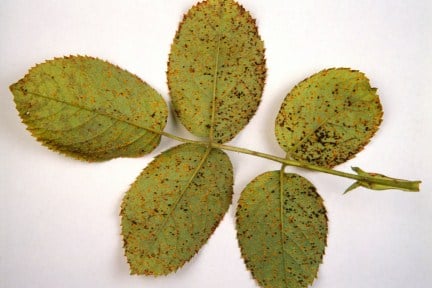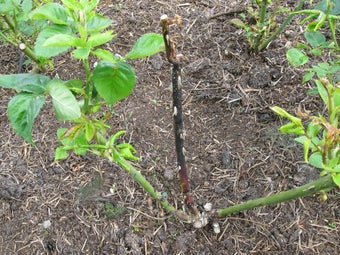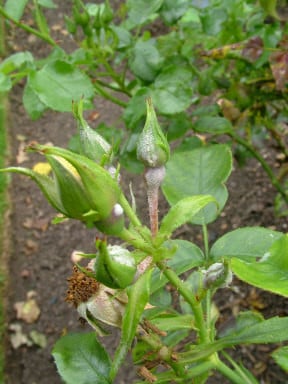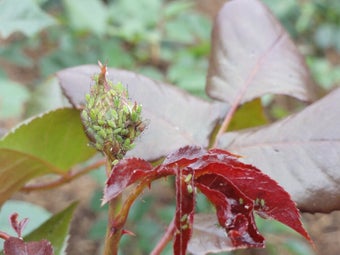
Quick facts
Common name - Rose rust
Scientific name - Phragmidium tuberculatum
Plants affected - Roses
Main symptoms - Orange or black pustules on leaves, orange pustules on stems
Caused by - Fungus
Timing - Spring and Summer
What is rose rust?
Rose rust is a disease caused by the parasitic fungus Phragmidium tuberculatum and some other closely related species. It is specific to roses, appearing in spring and persisting until the leaves fall.
Susceptibility to rust varies widely among rose cultivars, and many modern roses should be resistant to rust.
Rose rust is the least serious of the common rose diseases; black spot and rose powdery mildew are far more prevalent.
Symptoms
You may see the following symptoms:
- On stems: In spring, distorted young green stems, with large pustules of bright orange dusty spores
- On leaves: Yellow spots on the upper surfaces, corresponding to pustules of dusty orange spores on the lower surface. In late summer, the orange pustules turn black. Infected leaves may fall early

Control
The RHS believes that avoiding pests, diseases and weeds by good practice in cultivation methods, selection, and encouraging or introducing natural enemies, should be the first line of control. If chemical controls are used, they should be used only in a minimal and highly targeted manner.
Non-chemical control
- Prune out spring infections as soon as they are detected, to prevent the spread of spring spores
- Collect and destroy fallen leaves in autumn to reduce the number of overwintering resting spores
- If infections are persistently troublesome, it may be that the cultivar concerned is unusually susceptible, so consider replacing it with a different one (but be aware of potential problems from replant disease if another rose is planted in exactly the same spot)
Fungicides
The RHS recommends that you don't use fungicides. Fungicides (including organic types) may reduce , impact soil health and have wider adverse environmental effects. If you do intend to use a fungicide, please read the information given in the link and download below to ensure that use, storage and disposal of the product is done in a responsible and legally compliant manner.
The products listed in the ‘Fungicides for gardeners’ document below are legally available for use by home gardeners in the UK. This information is provided to avoid misuse of legal products and the use of unauthorised and untested products, which potentially has more serious consequences for the environment and wildlife than when products are used legally. Homemade products are not recommended as they are unregulated and usually untested.
Download
Fungicides for gardeners (Adobe Acrobat pdf document outlining fungicides available to gardeners)
Link
Biology
The fungus causing rose rust is, like all rusts, a biotroph: it infects the host tissues for extended periods without killing them, feeding from the living cells. Rusts are not able to feed from dead plant material, so must either alternate with a different, host, or produce a resting spore to pass the season.
Phragmidium tuberculatum and several other very similar rust species that infect roses do not have an alternate host; that is, they only attack roses and pass the winter as resting spores.
The first formed spores (spring spores) infect young stems and occasionally the stalks (petioles) and main veins of leaves, causing distortion and the production of bright orange pustules. Spores from these pustules in turn infect the leaves to produce dusty orange spores (summer spores) that are spread by wind and initiate further infections. Infection is favoured by prolonged periods of leaf wetness. In late summer, the pustules producing summer spores switch over to producing the dark, tough resting spores. These resting spores can survive the winter, on fallen leaves or often adhering to stems or trellises.
Infections may be severe enough to cause serious damage, but this is relatively rare and most infections are light enough not to require control.










